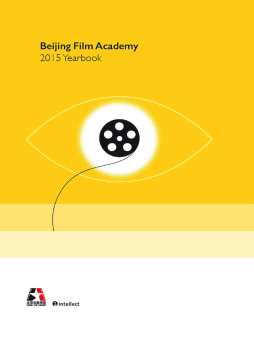
Additional Information
Book Details
Abstract
The Beijing Film Academy (BFA) is one of the most revered film institutions in the world. Since 1984, the BFA’s Department of Film Studies has been publishing the Journal of the Beijing Film Academy, the only journal of film theory that integrates film education in higher learning with film theory studies. Now, coinciding with dramatically increased interest in Chinese cinema, comes the Beijing Film Academy Yearbook, showcasing the best academic debates, discussions, and research from the academy in 2015 - all available for the first time in English. Aimed at narrowing the cultural gap for cross-cultural research, the book contributes not only to scholarly work on Chinese cinema, but also to film and media studies more generally.
Table of Contents
| Section Title | Page | Action | Price |
|---|---|---|---|
| Cover | i | ||
| Half Title | ii | ||
| Title | iv | ||
| Copyright | v | ||
| Contents | vi | ||
| Acknowledgements | viii | ||
| Foreword | x | ||
| Chapter 1 | 1 | ||
| A Wide Range of Academic Settings | 3 | ||
| A Rich and Solid Talent Cultivation System | 4 | ||
| An Interactive Academic Pattern of Teaching, Research and Creation | 5 | ||
| A Specialized and Versatile Training Mode | 6 | ||
| A Standardized and Effective ‘Double Practice’ (Social and Art Practice) System | 7 | ||
| A Comprehensive and High-level Platform for International Exchange | 8 | ||
| Strong Guarantee of Elite Education Conditions | 8 | ||
| Excellent Campus Culture | 9 | ||
| Conclusion | 10 | ||
| Endnote | 10 | ||
| Chapter 2 | 11 | ||
| Part I. Market Performance | 13 | ||
| Part II. Film-Making | 24 | ||
| Part III. The Dynamics of Film Enterprises and Industrial Management | 31 | ||
| Part IV. Conclusion | 40 | ||
| References | 41 | ||
| Note | 42 | ||
| Chapter 3 | 43 | ||
| Cinema Construction, Operation and Management | 46 | ||
| The Impact of e-Commercial Strategies on Cinema | 47 | ||
| Competition Between Cinemas and Internet Enterprises | 49 | ||
| Paying Attention to the Popular Mobile Payment Service | 50 | ||
| Diversify the Function of the Cinema Business Model | 51 | ||
| Pay Attention to the Audience’s Pre-Movie Consumer Psychology and Timing | 53 | ||
| Attract More Young Participants with Cinema Activities | 53 | ||
| Apply Diverse Operations and Promotion Modes | 54 | ||
| Future Operation and Development | 56 | ||
| References | 58 | ||
| Notes | 58 | ||
| Chapter 4 | 59 | ||
| The Present State and the Problems of China’s Film Industry | 61 | ||
| Distribution and Marketing | 64 | ||
| The Present Status and the Problems of China’s Cinema | 73 | ||
| The Marginalization of Non-Genre Film-Making and the Decline of Art-HouseCinema | 76 | ||
| The Root of the Problem Lies in the Lack of Film-Making Talents | 78 | ||
| Notes | 80 | ||
| Chapter 5 | 83 | ||
| The Current Situation and Features of Mainland Art Film Screening | 86 | ||
| Thematic Screening Should Emphasize Curating to Realize Educating andCommunicating Functions | 93 | ||
| Conclusion | 94 | ||
| References | 94 | ||
| Note | 95 | ||
| Chapter 6 | 97 | ||
| Tian Han and Jun’ichirō Tanizaki | 99 | ||
| The Influence of Jun’ichirō Tanizaki’s Work on Tian Han’s Film Dream by the Lake | 101 | ||
| Originality of Tian Han’s Works and Infl uencing Factors | 107 | ||
| Conclusion | 108 | ||
| References | 109 | ||
| Notes | 109 | ||
| Chapter 7 | 111 | ||
| The Intertextuality Between Yan Jin and Rudolph Valentino | 116 | ||
| The Intertextuality Between Plum Blossoms and the Eagle | 119 | ||
| The Intertextuality of Female Roles | 120 | ||
| The Intertextuality of the Lens Language Systems | 124 | ||
| Conclusion | 125 | ||
| References | 125 | ||
| Note | 126 | ||
| Chapter 8 | 127 | ||
| I. | 129 | ||
| II. | 131 | ||
| III. | 132 | ||
| IV | 136 | ||
| V. | 137 | ||
| References | 139 | ||
| Notes | 140 | ||
| Chapter 9 | 141 | ||
| Before the Battle: Planning, Investment and Production | 143 | ||
| During the Battle: Promotion, Distribution and Release | 146 | ||
| After the Battle: Comment, Reflection and Prospect | 150 | ||
| References | 152 | ||
| Note | 152 | ||
| Notes on Contributors | 153 | ||
| Editorial Board Information | 155 | ||
| Back Cover | 157 |
